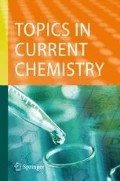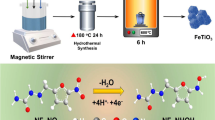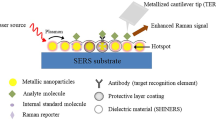Abstract
Titanium dioxide (TiO2) is increasingly being used in biosensing applications. Herein, we review the most recent developments in photoelectrochemical (PEC) and electrochemiluminescent (ECL) biosensing based on TiO2 nanomaterials, as well as the mechanisms that lead to the improved performance of biosensors that incorporate these nanomaterials. The merits of TiO2-based ECL and PEC biosensing strategies are summarized by highlighting some illustrative examples that have been reported within the last 5 years. The future prospects for and challenges in this field are also discussed.

Reproduced with permission from [32]

Reproduced with permission from [35]

Reproduced with permission from [41]
Similar content being viewed by others
References
Zhao W, Xu J, Chen H (2015) Photoelectrochemical bioanalysis: the state of the art. Chem Soc Rev 44(3):729–741. https://doi.org/10.1039/C4CS00228H
Zang Y, Lei J, Ju H (2017) Principles and applications of photoelectrochemical sensing strategies based on biofunctionalized nanostructures. Biosens Bioelectron 96:8–16. https://doi.org/10.1016/j.bios.2017.04.030
Shu J, Tang D (2019) Recent advances in photoelectrochemical sensing: from engineered photoactive materials to sensing devices and detection modes. Anal Chem. https://doi.org/10.1021/acs.analchem.9b04199
Liu Z, Qi W, Xu G (2015) Recent advances in electrochemiluminescence. Chem Soc Rev 44(10):3117–3142. https://doi.org/10.1039/C5CS00086F
Gao W, Saqib M, Qi L, Zhang W, Xu G (2017) Recent advances in electrochemiluminescence devices for point-of-care testing. Curr Opin Electrochem 3(1):4–10. https://doi.org/10.1016/j.coelec.2017.03.003
Chen Y, Zhou S, Li L, Zhu J (2017) Nanomaterials-based sensitive electrochemiluminescence biosensing. Nano Today 12:98–115. https://doi.org/10.1016/j.nantod.2016.12.013
Kumar N, Chauhan NS, Mittal A, Sharma S (2018) TiO2 and its composites as promising biomaterials: a review. Biometals 31(2):147–159. https://doi.org/10.1007/s10534-018-0078-6
Zang Y, Fan J, Ju Y, Xue H, Pang H (2018) Current advances in semiconductor nanomaterial-based photoelectrochemical biosensing. Chemistry 24(53):14010–14027. https://doi.org/10.1002/chem.201801358
Chen J, Kong L, Sun X, Feng J, Chen Z, Fan D, Wei Q (2018) Ultrasensitive photoelectrochemical immunosensor of cardiac troponin I detection based on dual inhibition effect of Ag@Cu2O core-shell submicron-particles on CdS QDs sensitized TiO2 nanosheets. Biosens Bioelectron 117:340–346. https://doi.org/10.1016/j.bios.2018.05.037
Pang X, Bian H, Wang W, Liu C, Khan MS, Wang Q, Qi J, Wei Q, Du B (2017) A bio-chemical application of N-GQDs and g-C3N4 QDs sensitized TiO2 nanopillars for the quantitative detection of pcDNA3-HBV. Biosens Bioelectron 91:456–464. https://doi.org/10.1016/j.bios.2016.12.059
Yang L, Liu X, Li L, Zhang S, Zheng H, Tang Y, Ju H (2019) A visible light photoelectrochemical sandwich aptasensor for adenosine triphosphate based on MgIn2S4–TiO2 nanoarray heterojunction. Biosens Bioelectron 142:111487. https://doi.org/10.1016/j.bios.2019.111487
Shu J, Qiu Z, Zhuang J, Xu M, Tang D (2015) In situ generation of electron donor to assist signal amplification on porphyrin-sensitized titanium dioxide nanostructures for ultrasensitive photoelectrochemical immunoassay. ACS Appl Mater Interfaces 7(42):23812–23818. https://doi.org/10.1021/acsami.5b08742
Liu X, Huo X, Liu P, Tang Y, Xu J, Liu X, Zhou Y (2017) Assembly of MoS2 nanosheet-TiO2 nanorod heterostructure as sensor scaffold for photoelectrochemical biosensing. Electrochim Acta 242:327–336. https://doi.org/10.1016/j.electacta.2017.05.037
Da P, Li W, Lin X, Wang Y, Tang J, Zheng G (2014) Surface plasmon resonance enhanced real-time photoelectrochemical protein sensing by gold nanoparticle-decorated TiO2 nanowires. Anal Chem 86(13):6633–6639. https://doi.org/10.1021/ac501406x
Pang X, Bian H, Su M, Ren Y, Qi J, Ma H, Wu D, Hu L, Du B, Wei Q (2017) Photoelectrochemical cytosensing of RAW264.7 macrophage cells based on a TiO2 nanoneedls@MoO3 array. Anal Chem 89(15):7950–7957. https://doi.org/10.1021/acs.analchem.7b01038
Zhang R, Zhong X, Chen A, Liu J, Li S, Chai Y, Zhuo Y, Yuan R (2019) Novel Ru(bpy)2(cpaphen)2+/TPrA/TiO2 ternary ECL system: an efficient platform for the detection of glutathione with Mn2+ as substitute target. Anal Chem 91(5):3681–3686. https://doi.org/10.1021/acs.analchem.8b05795
Zhou Y, Wang H, Zhuo Y, Chai Y, Yuan R (2017) Highly efficient electrochemiluminescent silver nanoclusters/titanium oxide nanomaterials as a signal probe for ferrocene-driven light switch bioanalysis. Anal Chem 89(6):3732–3738. https://doi.org/10.1021/acs.analchem.7b00090
Tang Y, Liu X, Zheng H, Yang L, Li L, Zhang S, Zhou Y, Alwarappan S (2019) A photoelectrochemical aptasensor for aflatoxin B1 detection based on an energy transfer strategy between Ce-TiO2@MoSe2 and Au nanoparticles. Nanoscale 11(18):9115–9124. https://doi.org/10.1039/C9NR01960J
Liu N, Chen S, Li Y, Dai H, Lin Y (2017) Self-enhanced photocathodic matrix based on poly-dopamine sensitized TiO2 mesocrystals for mycotoxin detection assisted by a dual amplificatory nanotag. New J Chem 41(9):3380–3386. https://doi.org/10.1039/C6NJ03157A
Dai H, Xu G, Zhang S, Hong Z, Lin Y (2015) A ratiometric biosensor for metallothionein based on a dual heterogeneous electro-chemiluminescent response from a TiO2 mesocrystalline interface. Chem Commun 51(36):7697–7700. https://doi.org/10.1039/C5CC01402F
Liu P, Liu X, Huo X, Tang Y, Xu J, Ju H (2017) TiO2–BiVO4 heterostructure to enhance photoelectrochemical efficiency for sensitive aptasensing. ACS Appl Mater Interfaces 9(32):27185–27192. https://doi.org/10.1021/acsami.7b07047
Fu B, Wu W, Gan L, Zhang Z (2019) Bulk/surface defects engineered TiO2 nanotube photonic crystals coupled with plasmonic gold nanoparticles for effective in vivo near-infrared light photoelectrochemical detection. Anal Chem 91(22):14611–14617. https://doi.org/10.1021/acs.analchem.9b03733
Zhao W, Wang J, Zhu Y, Xu J, Chen H (2015) Quantum dots: electrochemiluminescent and photoelectrochemical bioanalysis. Anal Chem 87(19):9520–9531. https://doi.org/10.1021/acs.analchem.5b00497
Cai G, Yu Z, Ren R, Tang D (2018) Exciton-plasmon interaction between AuNPs/graphene nanohybrids and CdS quantum dots/TiO2 for photoelectrochemical aptasensing of prostate-specific antigen. ACS Sensors 3(3):632–639. https://doi.org/10.1021/acssensors.7b00899
Wang L, Meng Y, Zhang C, Xiao H, Li Y, Tan Y, Xie Q (2019) Improving photovoltaic and enzymatic sensing performance by coupling a core-shell Au nanorod@TiO2 heterostructure with the bioinspired l-DOPA polymer. ACS Appl Mater Interfaces 11(9):9394–9404. https://doi.org/10.1021/acsami.8b19284
Yan Z, Wang Z, Miao Z, Liu Y (2016) Dye-sensitized and localized surface plasmon resonance enhanced visible-light photoelectrochemical biosensors for highly sensitive analysis of protein kinase activity. Anal Chem 88(1):922–929. https://doi.org/10.1021/acs.analchem.5b03661
Halawa MI, Lai J, Xu G (2018) Gold nanoclusters: synthetic strategies and recent advances in fluorescent sensing. Materials Today Nano 3:9–27
Zhu J, Huo X, Liu X, Ju H (2016) Gold nanoparticles deposited polyaniline–TiO2 nanotube for surface plasmon resonance enhanced photoelectrochemical biosensing. ACS Appl Mater Interfaces 8(1):341–349. https://doi.org/10.1021/acsami.5b08837
Hao N, Hua R, Chen S, Zhang Y, Zhou Z, Qian J, Liu Q, Wang K (2018) Multiple signal-amplification via Ag and TiO2 decorated 3D nitrogen doped graphene hydrogel for fabricating sensitive label-free photoelectrochemical thrombin aptasensor. Biosens Bioelectron 101:14–20. https://doi.org/10.1016/j.bios.2017.10.014
Wang Y, Zhao G, Zhang Y, Du B, Wei Q (2019) Ultrasensitive photoelectrochemical immunosensor based on Cu-doped TiO2 and carbon nitride for detection of carcinoembryonic antigen. Carbon 146:276–283. https://doi.org/10.1016/j.carbon.2019.02.008
Zhang Y, Li M, Wang H, Yuan R, Wei S (2019) Supersensitive photoelectrochemical aptasensor based on Br, N-codoped TiO2 sensitized by quantum dots. Anal Chem 91(16):10864–10869. https://doi.org/10.1021/acs.analchem.9b02600
Shu J, Qiu Z, Lv S, Zhang K, Tang D (2018) Plasmonic enhancement coupling with defect-engineered TiO2–x: a mode for sensitive photoelectrochemical biosensing. Anal Chem 90(4):2425–2429. https://doi.org/10.1021/acs.analchem.7b05296
Qiu Z, Shu J, Tang D (2018) Near-infrared-to-ultraviolet light-mediated photoelectrochemical aptasensing platform for cancer biomarker based on core–shell NaYF4:Yb, Tm@TiO2 upconversion microrods. Anal Chem 90(1):1021–1028. https://doi.org/10.1021/acs.analchem.7b04479
Tsuneyasu S, Ichihara K, Nakamura K, Kobayashi N (2016) Why were alternating-current-driven electrochemiluminescence properties from Ru(bpy)2+3 dramatically improved by the addition of titanium dioxide nanoparticles? Phys Chem Chem Phys 18(24):16317–16324. https://doi.org/10.1039/C6CP02881K
Zheng H, Yi H, Lin W, Dai H, Hong Z, Lin Y, Li X (2018) A dual-amplified electrochemiluminescence immunosensor constructed on dual-roles of rutile TiO2 mesocrystals for ultrasensitive zearalenone detection. Electrochim Acta 260:847–854. https://doi.org/10.1016/j.electacta.2017.12.054
Zheng H, Yi H, Dai H, Fang D, Hong Z, Lin D, Zheng X, Lin Y (2018) Fluoro-coumarin silicon phthalocyanine sensitized integrated electrochemiluminescence bioprobe constructed on TiO2 MOFs for the sensing of deoxynivalenol. Sens Actuators B Chem 269:27–35. https://doi.org/10.1016/j.snb.2018.04.149
Deng W, Chu C, Ge S, Yu J, Yan M, Song X (2015) Electrochemiluminescence PSA assay using an ITO electrode modified with gold and palladium, and flower-like titanium dioxide microparticles as ECL labels. Microchim Acta 182(5):1009–1016. https://doi.org/10.1007/s00604-014-1423-2
Zhao Y, Li L, Hu L, Zhang Y, Wu D, Ma H, Wei Q (2019) An electrochemiluminescence immunosensor for the N-terminal brain natriuretic peptide based on the high quenching ability of polydopamine. Microchim Acta 186(9):606. https://doi.org/10.1007/s00604-019-3709-x
Yang L, Zhu W, Ren X, Khan MS, Zhang Y, Du B, Wei Q (2017) Macroporous graphene capped Fe3O4 for amplified electrochemiluminescence immunosensing of carcinoembryonic antigen detection based on CeO2@TiO2. Biosens Bioelectron 91:842–848. https://doi.org/10.1016/j.bios.2017.01.055
Tian C, Wang L, Luan F, Zhuang X (2019) An electrochemiluminescence sensor for the detection of prostate protein antigen based on the graphene quantum dots infilled TiO2 nanotube arrays. Talanta 191:103–108. https://doi.org/10.1016/j.talanta.2018.08.050
Han Z, Shu J, Liang X, Cui H (2019) Label-free ratiometric electrochemiluminescence aptasensor based on nanographene oxide wrapped titanium dioxide nanoparticles with potential-resolved electrochemiluminescence. Anal Chem 91(19):12260–12267. https://doi.org/10.1021/acs.analchem.9b02318
Dai P, Yu T, Shi H, Xu J, Chen H (2015) General strategy for enhancing electrochemiluminescence of semiconductor nanocrystals by hydrogen peroxide and potassium persulfate as dual coreactants. Anal Chem 87(24):12372–12379. https://doi.org/10.1021/acs.analchem.5b03890
Wu X, Chai Y, Yuan R, Liang W, Yuan D (2014) A novel electrochemiluminescence choline biosensor based on biofunctional AMs-ChO biocomposite. Sens Actuators B Chem 204:429–436. https://doi.org/10.1016/j.snb.2014.07.125
Tang S, Zhao Q, Tu Y (2016) A sensitive electrochemiluminescent cholesterol biosensor based on Au/hollowed-TiO2 nano-composite pre-functionalized electrode. Sens Actuators B Chem 237:416–422. https://doi.org/10.1016/j.snb.2016.06.110
Yu L, Wei X, Fang C, Tu Y (2016) A disposable biosensor for noninvasive diabetic diagnosis rest on the Au/TiO2 nano-composite intensified electrochemiluminescence. Electrochim Acta 211:27–35. https://doi.org/10.1016/j.electacta.2016.06.034
Li X, Sun X, Fan D, Yan T, Feng R, Wang H, Wu D, Wei Q (2019) A ternary quenching electrochemiluminescence insulin immunosensor based on Mn2+ released from MnO2@carbon core-shell nanospheres with ascorbic acid quenching AuPdPt–MoS2@TiO2 enhanced luminol. Biosens Bioelectron 142:111551. https://doi.org/10.1016/j.bios.2019.111551
Liu G, Ma C, Jin B, Chen Z, Zhu J (2018) Direct electrochemiluminescence imaging of a single cell on a chitosan film modified electrode. Anal Chem 90(7):4801–4806. https://doi.org/10.1021/acs.analchem.8b00194
Cui C, Chen Y, Jiang D, Chen H, Zhang J, Zhu J (2019) Steady-state electrochemiluminescence at single semiconductive titanium dioxide nanoparticles for local sensing of single cells. Anal Chem 91(1):1121–1125. https://doi.org/10.1021/acs.analchem.8b04778
Zhou Y, Chai Y, Yuan R (2019) Highly efficient dual-polar electrochemiluminescence from Au25 nanoclusters: the next generation of multibiomarker detection in a single step. Anal Chem 91(22):14618–14623. https://doi.org/10.1021/acs.analchem.9b03736
Zeng X, Bai Y, Choi SM, Tong L, Aleisa RM, Li Z, Liu X, Yu R, Myung NV, Yin Y (2019) Mesoporous TiO2 nanospheres loaded with highly dispersed Pd nanoparticles for pH-universal hydrogen evolution reaction. Materials Today Nano 6:100038
Liang J, Xu Q, Teng X, Guan W, Lu C (2019) Superoxide-triggered luminol electrochemiluminescence for detection of oxygen vacancy in oxides. Anal Chem. https://doi.org/10.1021/acs.analchem.9b05156
Liao H, Zhou Y, Chai Y, Yuan R (2018) An ultrasensitive electrochemiluminescence biosensor for detection of microRNA by in situ electrochemically generated copper nanoclusters as luminophore and TiO2 as coreaction accelerator. Biosens Bioelectron 114:10–14. https://doi.org/10.1016/j.bios.2018.05.011
Acknowledgements
Funding from the National Natural Science Foundation of China (nos. 21874126 and 21675148) and The National Key Research and Development Program of China (no. 2016YFA0201300) are greatly appreciated.
Author information
Authors and Affiliations
Corresponding authors
Additional information
Publisher's Note
Springer Nature remains neutral with regard to jurisdictional claims in published maps and institutional affiliations.
This article is part of the Topical Collection “Surface-modified Nanobiomaterials for Electrochemical and Biomedicine Applications”; edited by “Alain R. Puente-Santiago, Daily Rodríguez-Padrón”.
Rights and permissions
About this article
Cite this article
Ma, X., Wang, C., Wu, F. et al. TiO2 Nanomaterials in Photoelectrochemical and Electrochemiluminescent Biosensing. Top Curr Chem (Z) 378, 28 (2020). https://doi.org/10.1007/s41061-020-0291-y
Received:
Accepted:
Published:
DOI: https://doi.org/10.1007/s41061-020-0291-y







